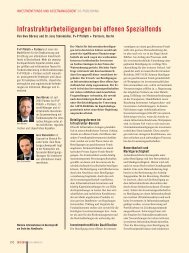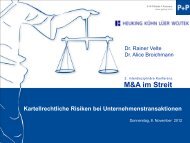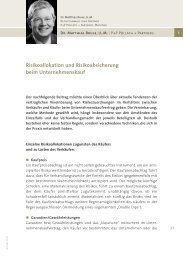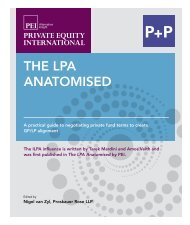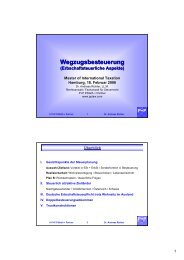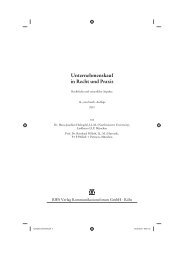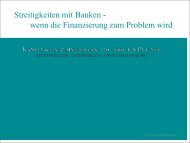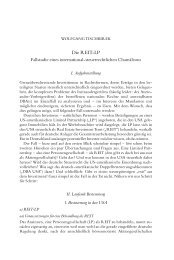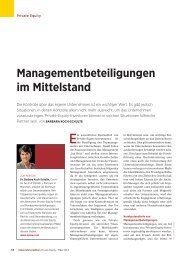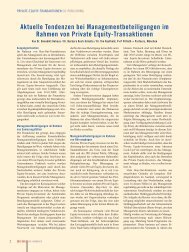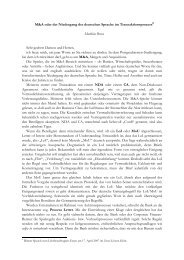Investissements étrangers en Allemagne Foreign Investments in ...
Investissements étrangers en Allemagne Foreign Investments in ...
Investissements étrangers en Allemagne Foreign Investments in ...
Create successful ePaper yourself
Turn your PDF publications into a flip-book with our unique Google optimized e-Paper software.
Possibilités d’<strong>in</strong>vestissem<strong>en</strong>t<br />
l’associé commanditaire n’a pas dedroits de gestion<br />
(commanditaire « typique ») Toutefois, ces<br />
droits de gestion (<strong>in</strong>ternes) peuv<strong>en</strong>t être stipulés<br />
dans lecontrat conclu par l'associé commanditaire<br />
(statut de commanditaire « atypique »).<br />
Par rapport aux tiers, la société est uniquem<strong>en</strong>t<br />
gérée par les associés non commanditaires. La<br />
structure juridique externe del’associé commanditaire<br />
est par conséqu<strong>en</strong>t similaire àcelle d'un prêt<br />
(subordonné).<br />
Investm<strong>en</strong>t Possibilities<br />
have any manag<strong>in</strong>g rights (“typical” sil<strong>en</strong>t partnership).<br />
However, such (<strong>in</strong>ternal) manag<strong>in</strong>g rights<br />
may bestipulated <strong>in</strong> the sil<strong>en</strong>t partnership agreem<strong>en</strong>t<br />
(“atypical” sil<strong>en</strong>t partnership).<br />
In relation to third parties, the company is managed<br />
bythe non-sil<strong>en</strong>t partners only. The external<br />
legal structure of the sil<strong>en</strong>t partnership is<br />
therefore similar to a(subord<strong>in</strong>ated) loan.<br />
b) Part<strong>en</strong>ariats public-privé (PPP) b) Public Private Partnerships (PPPs)<br />
Dans les PPP, les <strong>in</strong>vestisseurs privés etcerta<strong>in</strong>s<br />
organismes publics coopèr<strong>en</strong>t pour développer,<br />
exploiter ou <strong>en</strong>tret<strong>en</strong>ir certa<strong>in</strong>s projets àlong terme,<br />
des projets d’<strong>in</strong>frastructures comme la construction<br />
de voies publiques (par ex. l’autoroute (Autobahn),<br />
les systèmes depéage, la gestion des déchets ou<br />
des eaux usées sont des exemples typiques de<br />
PPP.<br />
Les PPP <strong>en</strong> <strong>Allemagne</strong> ne sont pas régis par des<br />
textes législatifs spécifiques. En conséqu<strong>en</strong>ce, les<br />
PPP exig<strong>en</strong>t des contrats de jo<strong>in</strong>t v<strong>en</strong>ture écrits et<br />
détaillés, mais sous réserve de l’accord contractuel<br />
<strong>en</strong>tre les parties, l’<strong>in</strong>vestisseur privé est responsable<br />
delaplanification, de la mise <strong>en</strong> place etdu<br />
f<strong>in</strong>ancem<strong>en</strong>t du projet. En retour, il peut accéder à<br />
de nouveaux doma<strong>in</strong>es commerciaux l’apanage <strong>en</strong><br />
général du secteur public.<br />
In PPPs, private <strong>in</strong>vestors and public bodies cooperate<br />
to develop, operate or ma<strong>in</strong>ta<strong>in</strong> certa<strong>in</strong><br />
long-term projects. Infrastructure projects like the<br />
build<strong>in</strong>g of highways (e.g. the Autobahn), toll<br />
charge systems, waste managem<strong>en</strong>t or waste<br />
water disposal are typical examples for PPPs.<br />
PPPs <strong>in</strong> Germany are not governed by any specific<br />
statutory law. As aconsequ<strong>en</strong>ce, PPPs require<br />
detailed writt<strong>en</strong> jo<strong>in</strong>t v<strong>en</strong>ture contracts. G<strong>en</strong>erally,<br />
but subject to the contractual agreem<strong>en</strong>t betwe<strong>en</strong><br />
the parties, the private <strong>in</strong>vestor is responsible for<br />
plann<strong>in</strong>g, establish<strong>in</strong>g and f<strong>in</strong>anc<strong>in</strong>g the project. In<br />
exchange, the private <strong>in</strong>vestor ga<strong>in</strong>s access to<br />
new bus<strong>in</strong>ess areas g<strong>en</strong>erally <strong>en</strong>gaged by the<br />
public sector.<br />
5. Sociétés europé<strong>en</strong>nes 5. European Companies<br />
En plus des sociétés nationales susm<strong>en</strong>tionnées<br />
pour la constitution <strong>en</strong> société ou l’établissem<strong>en</strong>t<br />
d’une affaire, deux formes sociétaires de droit<br />
europé<strong>en</strong> sont oudevi<strong>en</strong>dront disponibles dans les<br />
Etats membres de l’UE et de l’Espace économique<br />
europé<strong>en</strong> (EEE) y compris l’<strong>Allemagne</strong>. Il s’agit<br />
notamm<strong>en</strong>t delaSEetdelaSPE.<br />
In addition to the aforem<strong>en</strong>tioned national legal<br />
<strong>en</strong>tities for the <strong>in</strong>corporation orestablishm<strong>en</strong>t of a<br />
bus<strong>in</strong>ess, two legal forms based on European law<br />
have or shall become available <strong>in</strong> the member<br />
states of the EU and the European Economic Area<br />
(EEA), <strong>in</strong>clud<strong>in</strong>g Germany, notably the SE and the<br />
SPE.<br />
a) La société europé<strong>en</strong>ne (SE) a) European Stock Corporation (SE)<br />
La société europé<strong>en</strong>ne (nommée par son nom lat<strong>in</strong><br />
Societas Europaea,) est l’équival<strong>en</strong>t europé<strong>en</strong><br />
d’une AG. Le cadre légal de la SE compr<strong>en</strong>d le<br />
Droit dela Communauté europé<strong>en</strong>ne directem<strong>en</strong>t<br />
applicable dans tous les Etats membres del’UE et<br />
les Etats membres du traité de l’EEE, a<strong>in</strong>si que, et<br />
dans une large mesure, aux législations nationales<br />
respectives édictées dans lecadre de la transposition<br />
de la SE au se<strong>in</strong> des différ<strong>en</strong>ts systèmes juridiques.<br />
Une SEpeut être constituée de c<strong>in</strong>q façons<br />
différ<strong>en</strong>tes :<br />
The European Company (d<strong>en</strong>oted by its Lat<strong>in</strong><br />
name Societas Europaea) isaEuropean AG. The<br />
legal framework of the SEisbased on European<br />
Community law directly applicable <strong>in</strong> all EUmember<br />
states and the member states of the EEA<br />
Conv<strong>en</strong>tion, as well as –and to alarger practical<br />
degree –onthe respective relevant national legislation<br />
<strong>en</strong>acted toimplem<strong>en</strong>t the SE <strong>in</strong> the differ<strong>en</strong>t<br />
jurisdictions. An SE can be <strong>in</strong>corporated <strong>in</strong> five<br />
ways:<br />
► fusion des deux sociétés par actions, ► merger of two stock corporations,<br />
► Intégration delaSEhold<strong>in</strong>g conjo<strong>in</strong>te, ► <strong>in</strong>corporation of jo<strong>in</strong>t hold<strong>in</strong>g SE,<br />
► Intégration delaSEfiliale conjo<strong>in</strong>te, ► <strong>in</strong>corporation ofjo<strong>in</strong>t subsidiary SE,<br />
14



